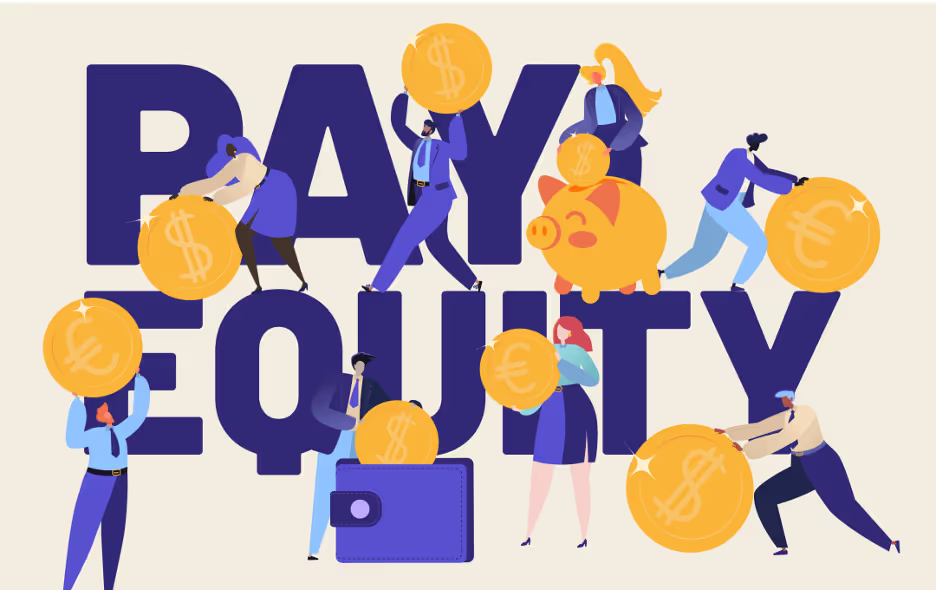Unlock Pay Equity with the Right Solutions for Your Business

Pay equity refers to the idea that all employees, irrespective of their color, gender, ethnicity, or other social status, should get comparable compensation for executing alike job functions. However, this approach is often more intricate than getting free of prejudices. Other considerations for employers include
● The candidate's training and work history.
● The demands of the position.
● The organization's long-term financial health.
What makes pay equity crucial?
Because it tackles the undervaluation of women's labor, which leads to the gender wage gap, pay equity is crucial.
Even though labor is as valuable as talent, effort, responsibility, and working circumstances, positions that women frequently hold typically pay less than jobs commonly held by males.
The gender pay gap still remains an issue today; in Canada, a woman made 0.89 cents for every dollar a man made in 2020. This equates to an hourly salary difference between men and women of $3.52, or 11%.

What laws in the United States regulate pay equity?
Early in the 1960s, federal regulations addressing pay fairness were first passed. The two standouts are:
● As per 1963'w Equal Pay Act, women and men who work for the same company should be paid equally for comparable work.
● Title VII of 1964's Civil Rights Act provides more safeguards than the Equal Wage Act and forbids pay discrimination based on racial, ethnic, religious, and national origin factors in addition to gender.
Example of Pay Equity
According to the Equal Pay Act, job function is more significant than the job title. Consider secretaries and administrative assistants. Since both of these roles are normally of a similar type, if one was done by a man and the other by a woman, and both had an equivalent degree of education and experience, then the law should require that they be paid about equally.
The state of pay equity today
Equal pay safeguards are provided by almost all state statutes in addition to federal ones. Unfortunately, many ignore the unfair wage practices of some businesses and organizations. According to equalpaytoday.org, women made 82 cents for every $1 earned by men in 2021, and the difference is significantly greater for women of color. The Economic Policy Institute found that the salary disparity between white and black workers was wider in 2016 than in 1979.
However, wage fairness has emerged as one of the hottest concerns in today's culture, garnering attention from social media to celebrity campaigners. As a result, state and local governments continue to implement adjustments.
How are local and state governments handling the issue of wage equity?
Almost every state has equal pay legislation, varying in complexity. In New York, for instance, "essentially equivalent" work is now included in the definition of "equal work."
Law for pay scale disclosure
According to some parts of the nation, transparency is crucial to enhancing wage parity. The most stringent in this regard are Colorado and New York City (starting November 2022), which mandate that employers disclose the minimum and maximum salary range in their job adverts. To comply with these rules, which may set a precedent in other states, employers will require reliable salary data more than ever.
Bans on salary history
State and local governments are also combating pay discrimination by outlawing inquiries into past salaries. These restrictions differ widely, much like other pay equity laws. For example, legislation could:
● Stop employers from basing compensation decisions on past wages
● Limit inquiries about past salaries
● Permit post-offer inquiries but not pre-offer inquiries
● Differentiate between internal and external job applicants
Employers should examine the websites of their respective state legislatures or consult legal advice to help assure compliance with state and local pay equity regulations.
What changes or enhancements may employers make to their pay equity policies?
Examining current corporate policies critically and implementing proactive adjustments, such as revising job descriptions and pay structures to reflect new policies, are common first steps in complying with pay equity legislation.

● Educating staff members on the company's pay equity objectives and its strategies for achieving them
● Changing recruitment and talent management strategies if one race or gender dominates in a department or certain roles
● Performing a pay equity analysis to locate and close any compensation inequalities that might be caused by discrimination
● Collaborating with a professional employer organization(PEO) to manage pay audits and further support.
An analysis of pay equity
An organizational pay disparity can be found statistically using a pay equity analysis. It compares pay scales with various factors, including seniority, education, ethnicity, and gender. If legal, non-discriminatory factors cannot account for discrepancies, the employer must conduct additional research and take corrective action.
How do employers carry out an audit or analysis of pay equity?
The difficult procedure of a pay equity audit necessitates data analysis as well as the knowledge of financial consultants and attorneys. Businesses that have access to these resources typically take the following actions:
● Prepare the ground: With the help of the audit's main stakeholders, decide on the auditor's approach, scope, budget, and schedule.
● Understanding historical context: Any possible problems discovered as a consequence of the audit can be resolved with knowledge of how the current pay scales were developed.
● Data on the workforce: The information acquired depends primarily on the audit's scope, although most studies consider characteristics like job function, gender, race, experience, length of service, and work performance.
● Employees with similar job functions should be compared: Employers should be aware of their state's pay equity regulations throughout the comparison because some have broader definitions of "equivalent labor" than the federal government. Using "comparable" and "substantially similar" standards is possible.
● Review and analyze the results: Do not immediately infer that salary disparities are fraudulent if uncovered. In general, evaluations based on merit, seniority, and the volume or caliber of work are appropriate. Pay attention to any pay differences that might be directly related to protected traits.
● Correcting unjustified salary gaps: Discuss the most prudent manner to raise the pay of any employees who may have been the target of discrimination with experts in HR and finance. In general, salary reductions to close wage discrepancies are forbidden.
How is pay equity determined?
You may quickly determine how equitable the pay at your organization is by following a few easy steps:
● For the demographic, you want to compare, add the yearly earnings of the full-time, year-round employees. You can choose another factor, such as ethnicity or gender, to be that.
● Find the median pay for each demographic. With 50% of the population making more than that wage and 50% making less, the salary falls squarely in the middle.
● The pay gap can be calculated by comparing the median salaries for each of your demographic group’s side by side.
Although some businesses would consider this approach unduly basic, pay fairness can also be determined using average salaries by demography. Additionally, businesses may compute based on weekly compensation, which could produce significantly different results.
Even while this approach is a fine place to start, determining salary disparities should be done on a variety of metrics. Investigating additional elements that might contribute to wage inequality may be beneficial.
What are some pay equity best practices?
Employers may be able to lessen pay inequity in addition to conducting a pay equity audit by adhering to best practices, such as these:
● Review trends in compensation: Keep track of how pay compares to various employee groups and utilize outside benchmarks to develop hiring and compensation procedures that adhere to industry norms.
● Be open and honest about compensation: When workers understand how pay choices are made, it fosters a culture of trust and forces management to defend that promotions are merit-based.
● Interdiction of salary negotiations: Instead of responding to employees who demand more money or threaten to quit, base incentives and raise son clearly stated objectives.
● Set budget priorities: Closing pay inequalities necessitates a financial investment; therefore, it demands smart budgeting and the capacity to handle competing objectives.
Conclusion
Compensation equality involves more than just getting equal pay for equal effort, although that is undoubtedly one of its main goals. To develop pay scales based on merit, employers must also consider the education, experience, or skill level, number of years with the company, and performance of their employees.
FAQs
- The Equal Pay Act is what?
The Equal Pay Act for Equal Work Amendment forbids salary discrimination based on gender. It applies to both men and women who work for the same business and have essentially equivalent positions that encompass all forms of compensation. If it is found that there is a salary gap between those who fit these requirements, the employer must close it by increasing wages rather than lowering them.
- How are wage disparities determined?
The median earnings of men and women are typically divided, with the result expressed as a ratio or percentage, to estimate the gender pay gap. Results varied based on whether or not factors like occupation, hours worked, education, and work experience were considered when adjusting the salaries.
- How can internal pay equity be ensured?
To be completely realized, achieving pay equity is a multifaceted process that takes time and, depending on internal resources, may require outside assistance. Despite these obstacles, companies may often guarantee that their compensation plans are equitable by:
● Examining the compensation offered by competitors in the same field
● Avoiding pay talks, which can penalize women and underrepresented groups
● Entirely based on merit and performance for promotions and raises
● Examining pay equality audit findings to look for indications of salary discrimination
Find out how Compport can help you manage all your Pay Equity process, book a demo today!
%2520(6)%2520(2).avif)


%20(49).png)
%20(48).png)
%20(47).avif)
